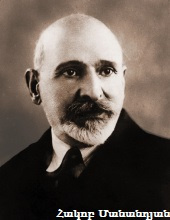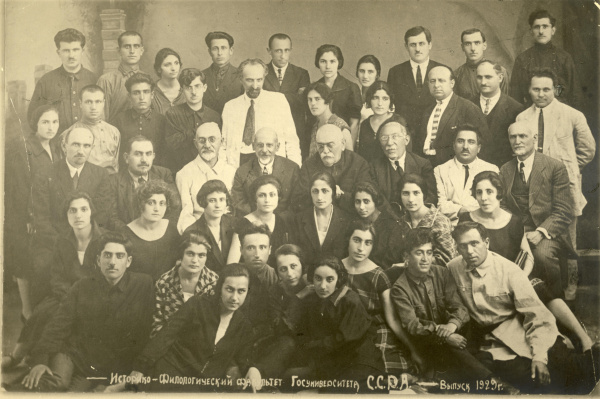
Historian, philologist, source scholar, Ph.D., professor, academician of the Academy of Sciences of the USSR and the Academy of Sciences of the USSR, honored figure of science of the USSR
Manandyan was born on November 22, 1873, in Akhaltskha. He received his primary education in 1880-1883 at Karapetyan College. In 1883-1893 studied at Tbilisi 1st gymnasium, and in 1893-1897 at the Universities of Jena, Leipzig, and Strasbourg, receiving a Ph.D. degree. In 1898, Manandyan graduated from the Oriental Languages Faculty of St. Petersburg University, and in 1909, from the Faculty of Law of Dorpat University.
In 1900-1905 H. Manandyan taught at the Gevorgian Seminary in Etchmiadzin, in 1905-1907 at the first and second male gymnasiums in Tbilisi, in 1906-1907 at the Nersisian School, in 1911-1913 at the Baku People's University and in 1915-1919 at the commercial school. In December 1919, he was invited to YSU, and appointed as acting dean of the Faculty of History and Linguistics, in 1920-1921 he served as the Rector, in 1921-1923, as the Dean of Oriental Studies and Historiography Faculties, in 1921-1925: Head of the Chair of Armenian history, 1925-1931: Professor of the same Chair. In 1925, H. Manandyan received the rank of professor, and in 1938, he became a Ph.D. In 1925, Manandyan was elected a member of the Institute of Science and Crafts of Armenia, in 1939 and 1943 - Academician of the Academy of Sciences of the USSR.

At YSU, he was the first to teach the ancient and medieval history of the Armenian people. In 1931, he interrupted the pedagogical work and engaged only in scientific activity.
H. Manandyan is one of the outstanding representatives of Armenian historiography. He is the author of more than 150 works in Armenian, Russian, and German, dedicated to Armenian ancient and medieval history and philology, historical geography, metrology, and culture. He was engaged in the study of the Armenian translations of Greek philosophical works, and activities of Hellenizing School, especially the philosophical legacy of Davit Invincible. In this field, the study of "Hellenizing School and the Periods of its Development" (Vienna, 1928) is a permanent value of Armenian studies. Among the enduring works of Armenian historiographical thought are "About Trade and Cities of Armenia" (Russian, Yerevan, 1930, 1954, 1985), "Feudalism in Ancient Armenia" ( Yerevan, 1934, 1981) dedicated to the social-economic relations of ancient and medieval Armenia, "Weights and Measures in Ancient Armenian Sources" (Yerevan, 1930, 1985), "Main Roads of Ancient Armenia" (Yerevan, 1936, 1985), "Tigran II and Rome" (Yerevan, 1940, 1972, 1977, Russian: 1943, French: 1963) and other monographs.
Manandyan undertook the creation of the multi-volume work "Study of the History of the Armenian People" to describe the complete history of Armenia in BC. VI – XVI (vols. I-III, 1945, 1952, 1957, also 1977, 1978), which, however, remained unfinished. In 1902 with the cooperation of Hr. Acharyan, Manandyan published all the known originals of the Armenian witness literature of the XII-XIX centuries (Vol. I-II), prepared for a scientific publication the originals of the Armenian translations of the works of ancient Greek philosophers (Nonos, Elias, Zeno the Citium, Aristotle, and others).
In 1935, H. Manandyan became an honored figure of science of the ASSR. He was awarded with the "Labor Red Banner" order, many medals, and certificates of honor.
H. Manandyan’s bronze bust in the lobby of YSU's central building symbolizes the role of an outstanding scientist-pedagogue in the foundation, establishment, and development of university science.
Manandyan passed away on February 4, 1952, in Yerevan.

